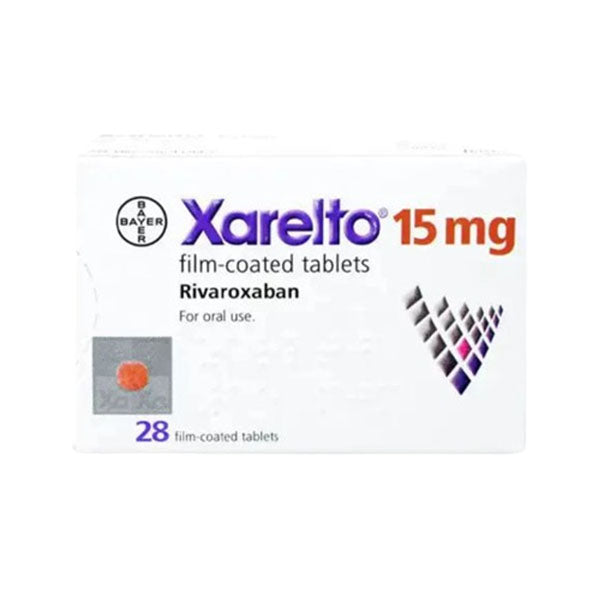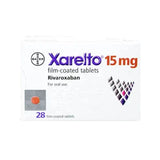Xarelto 15 mg 42 tablets:
Rivaroxaban film-coated tablets 15 mg.
What is rivaroxaban and what is it used for:
- Rivaroxaban is used in adults to:
- Prevent blood clots in your brain (stroke) and other blood vessels in your body if you have a form of irregular heartbeat called non-valvular atrial fibrillation.
- Treat blood clots in the veins of your legs (deep vein thrombosis) and in the blood vessels in your lungs (pulmonary embolism),
- To prevent recurrence of blood clots in the blood vessels in your legs and/or lungs.
How to take rivaroxaban:
- To prevent blood clots in the brain (stroke) and other blood vessels in the body
- The recommended dose is one rivaroxaban 20 mg tablet once a day.
- If you have kidney problems, the dose may be reduced to one rivaroxaban 15 mg tablet once a day.
- If you need a procedure to treat blockages in the blood vessels in your heart, there is limited evidence to reduce the dose to one tablet of rivaroxaban 15 mg once a day plus an antiplatelet medicinal product such as clopidogrel.
- To treat blood clots in the veins of your legs and blood clots in the blood vessels in your lungs, and to prevent blood clots from occurring again.
- The recommended dose is one rivaroxaban 15 mg tablet twice a day for 3 weeks. For treatment after 3 weeks, the recommended dose is one rivaroxaban 20 mg tablet once a day.
- After at least 6 months of blood clot treatment, your doctor may decide to continue treatment with either one 10 mg tablet once a day or one 20 mg tablet once a day.
- If you have kidney problems and are taking one rivaroxaban 20 mg tablet once a day, your doctor may decide to reduce the dose for treatment after 3 weeks to one rivaroxaban 15 mg tablet once a day if the risk of bleeding is greater than the risk of another blood clot.
Do not take rivaroxaban:
- If you are allergic to rivaroxaban or to any of the other ingredients of this medication
- If you are bleeding heavily
- If you have a disease or condition in one of your body parts that increases your risk of serious bleeding (such as a stomach ulcer, injury or bleeding in the brain, or recent brain or eye surgery)
- If you are taking medications to prevent blood clotting (such as warfarin, dabigatran, apixaban, or heparin), except when changing your anticoagulant treatment or while receiving heparin through an intravenous or arterial line to keep it open.
- If you have liver disease that increases the risk of bleeding
- If you are pregnant or breastfeeding
Warnings and precautions:
- Take special care with rivaroxaban.
- If you have an increased risk of bleeding, as in some cases (such as severe kidney disease, lung disease, if you have an artificial heart valve,
- If you are taking other medications to prevent blood clotting, in case of bleeding disorders or stomach or intestinal diseases)
- If you have an artificial heart valve
- If you know you have a disease called antiphospholipid syndrome (an immune system disorder that increases the risk of blood clots),
- Tell your doctor who will decide if your treatment needs to be changed.
- If your doctor decides that your blood pressure is unstable or if another treatment or surgical procedure is planned to remove the blood clot from your lungs
Possible side effects of rivaroxaban:
- These include low red blood cells that can make the skin pale and cause weakness or shortness of breath, stomach or intestinal bleeding, bleeding in the genitourinary system, nosebleeds,
- Bleeding in the gums, bleeding in the eye, bleeding into the tissue or body cavity (hematoma, bruising), coughing up blood, bleeding from the skin or under the skin, bleeding after surgery,
- Bleeding of blood or fluid from a surgical wound, swelling in the extremities, pain in the extremities, poor kidney function (can be seen in tests done by your doctor), fever, stomach pain,
- Indigestion, feeling or illness, constipation, diarrhea, low blood pressure, decreased general strength and energy (weakness, fatigue), headache, dizziness, rash, itchy skin.
Other medications and rivaroxaban:
- Tell your doctor if you are taking any of the following medications:
- Certain medications for fungal infections (such as fluconazole, itraconazole, voriconazole, posaconazole), unless they are applied only to the skin
- Ketoconazole tablets (used to treat Cushing's syndrome – when the body produces an excess of cortisol)
- Certain medications for bacterial infections (such as clarithromycin and erythromycin)
- Certain antiviral medications for HIV/AIDS (such as ritonavir)
- Other medications to reduce blood clotting (such as enoxaparin, clopidogrel, or vitamin K antagonists such as warfarin and acenocoumarol)
- Anti-inflammatory medications and pain relievers (such as naproxen or acetylsalicylic acid)
- Dronedarone, a medicine to treat abnormal heart rhythms
- Some medications to treat depression
- Certain medications to treat epilepsy (phenytoin, carbamazepine, phenobarbital)
- St. John's Wort, an herbal product used to treat depression
- Rifampicin, an antibiotic.


